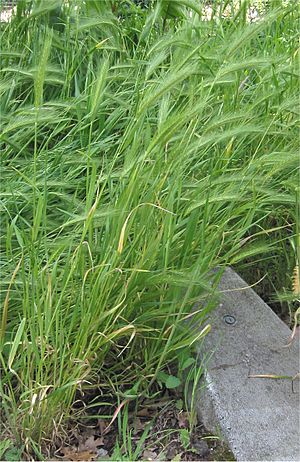Wall barley facts for kids
Quick facts for kids Wall barley |
|
|---|---|
 |
|
| Scientific classification | |
| Genus: |
Hordeum
|
| Species: |
murinum
|
| Subspecies | |
|
|
Hordeum murinum, often called wall barley or false barley, is a type of grass. It's a common plant found in many places around the world.
Contents
About Wall Barley
Wall barley is very common and grows in many areas. In the British Isles, you'll find it a lot in England and Wales, but not so much in Ireland or Scotland. It usually flowers from May to July, especially near the coast.
This grass can grow up to 30 centimeters (about 1 foot) tall. Its straight spikes, which are like the seed heads, can be up to 10 centimeters long. Wall barley produces small, dry seeds. Its leaves can be 8 millimeters wide and have short, flat parts called ligules.
Wall barley is an annual winter plant. This means its seeds start to grow in the spring, and the plant lives for about a year. It's also known as wall barley and has a special genetic makeup. It's different from other types of Hordeum grasses because of how it looks and its unique genes. It also has trouble mixing with other Hordeum species.
One of its well-known types is called hare barley.
Where Wall Barley Grows Best
The Hordeum murinum group of grasses is the most common of all Hordeum species. It mostly grows in the Mediterranean area, Central Europe, Western Asia, and North Africa.
For wall barley to grow well and produce many seeds, it needs a good amount of rain spread out over time. Rain is the most important thing for its seeds to grow. If it's too dry, or if the rain comes too early or too late, the plant might not be able to grow new seeds. This grass uses a lot of its energy to make seeds, which helps it live in places with different amounts of water.
Farmers can control how much wall barley grows by planting the right amount of seeds. Planting more seeds helps produce more barley for animals to eat. This helps get good, steady food for animals in places like Jordan. The height of the plant and how much protein it has can change each year, but they don't depend on how many seeds are planted.
Different Kinds of Wall Barley
One type of wall barley is Hordeum murinum ssp. leporinum, which is known as hare barley, mouse barley, or barley grass. In China, it's called màiqīng (麦青). It's a common ingredient in a special snack called qīngtuán (青糰), which is eaten in the spring during the Qingming Festival.
Hare barley grows in clumps from 10 to 40 centimeters tall. Its flowers grow on small branches, not directly on the main stem. This type of barley comes from the Mediterranean region, North Africa, and parts of Asia. It has also spread to many other places around the world.
Another type is H. m. ssp. glaucum. This one grows in warmer parts of the Mediterranean region.
These different types of wall barley are mainly different because of their number of chromosomes, how their seed heads look, and where they grow. Hare barley is more common in places that get more than 425 millimeters of rain. H. glaucum is found more in dry areas that get less than 425 millimeters of rain.
How Wall Barley is Used
Wall barley is an important part of pastures where animals graze. It provides good food for animals like cattle, especially in areas where there isn't much water.
Fun Facts About Wall Barley
In England, in the late 1900s, children sometimes called wall barley the 'Flea Dart'. They gave it this name because its seed head looks like a dart and because tiny insects called aphids are often found on it when it's young.
See also
 In Spanish: Cebadilla ratonera para niños
In Spanish: Cebadilla ratonera para niños

